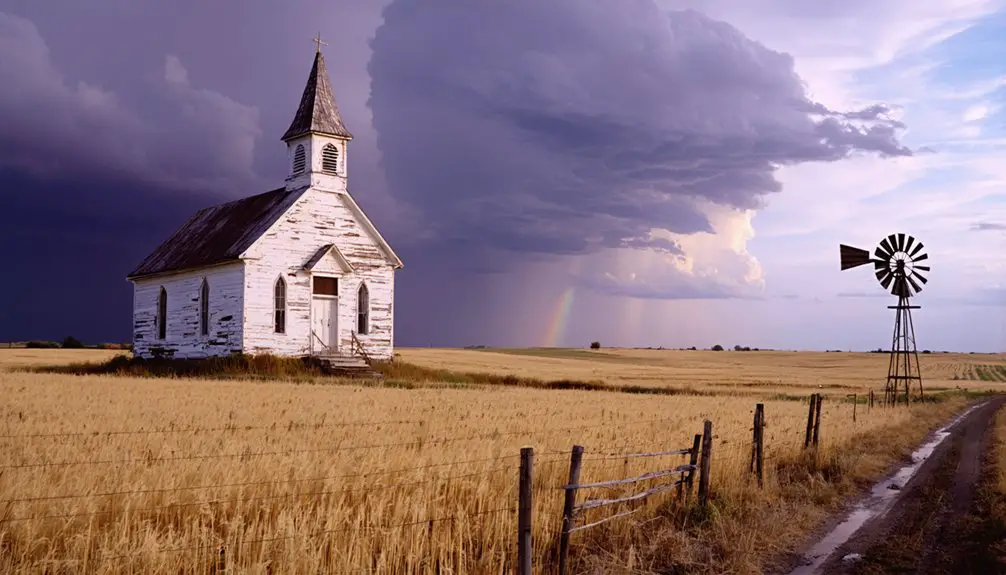You’ll find the ghost town of Neuchatel in Nemaha County, Kansas, where Swiss brothers Ami and Charles Bonjour established a French-speaking settlement in 1852. The community thrived around its Presbyterian church, schoolhouse, and post office until the railroads bypassed it after the Civil War. Though once home to nearly 400 residents, Neuchatel’s population dwindled to just over 100 by 1901. Today, only scattered remnants along Old Pike’s Peak Trail Road hint at deeper stories of this forgotten Swiss-French pioneer town.
Key Takeaways
- Neuchatel was founded in 1852 by Swiss brothers Ami and Charles Bonjour, named after their Swiss homeland in Canton Neuchâtel.
- The town’s decline began when railroads bypassed it after the Civil War, while neighboring towns like Atchison prospered.
- Economic troubles intensified with the failure of the Mill Co. steam mill and post office closure in 1901.
- Population dropped from 392 to 117 as younger generations left due to limited job opportunities and economic isolation.
- Only scattered remnants remain today along Old Pike’s Peak Trail Road and C Road in Nemaha County.
The Swiss-French Settlement Roots

In 1852, the foundations of Neuchatel were laid when Swiss brothers Ami and Charles Bonjour emigrated from Switzerland to Indiana before making their way to Kansas by 1857. The brothers, originally from Lignières village in the Canton of Neuchâtel, named their new settlement after their homeland, establishing a stronghold of Swiss-French cultural heritage in the American frontier.
You’ll find that these pioneering families were deeply connected, with multiple branches of Bonjours, Simons, and Zurchers settling the area. They actively recruited other Swiss-French families from Indiana, creating a close-knit community where French remained the primary language. The community grew steadily as Reverend Eugene Laporte ministered to the pioneers during their formative years from 1862 to 1866.
Their commitment to linguistic preservation shaped the settlement’s character, as evidenced by French-speaking stores, schools, and churches that emerged by the 1860s. The early settlers initially lived in dugouts and cellars while working to establish their permanent homesteads in the region.
Early Pioneers and Territorial Days
While the Bonjour brothers laid Neuchatel’s Swiss-French foundations, the area’s first recorded settlers were actually Ezra and Steve Lot from New York State, who arrived in 1856. The pioneer hardships began immediately, with early settlers renting land from territorial governance and cutting hay with scythes to survive.
When Charles and Ami Bonjour arrived in May 1857, they were soon joined by Fred H. Bonjour and L. August Zurcher. These determined pioneers established the core settlement just as Kansas Territory was finding its footing. The settlement was situated along the Parallel Road, which connected Atchison to the Colorado gold mines.
Despite the challenges of frontier life, you’ll find their resilience shaped the community’s character. The settlers maintained essential connections to supply centers like Leavenworth, and by 1864, they’d secured their own identity with a post office named “Neuchatel,” honoring their Swiss heritage. The post office served the community faithfully until it closed in 1901.
Community Life in Neuchatel Township
Through shared Swiss-French heritage and cultural bonds, Neuchatel Township’s residents created a vibrant community life centered around their Presbyterian church, schoolhouse, and post office.
You’d find the heartbeat of their cultural heritage pulsing through community gatherings that brought settlers together for mutual support and fellowship.
Life in Neuchatel revolved around:
- Regular church services and social functions at the Presbyterian church
- Educational activities at the local schoolhouse where children learned together
- Daily interactions at the post office, a hub for news and communication
- Cooperative farming efforts where neighbors helped each other during harvest
Despite challenges like young men leaving for the Civil War, the tight-knit French-speaking settlers maintained strong social connections through shared language, traditions, and collaborative work, fostering a resilient spirit that defined their community. Like many other settlements in Nemaha County, the community relied heavily on the emigrant trails for transportation and trade connections. Today, visitors can still see the restored structures including the cemetery, church, town hall, and schoolhouse that stand as testament to this once-thriving community.
The Impact of Railroad Development
As railroads rapidly expanded across Kansas after the Civil War, Neuchatel’s fate took an unfortunate turn when major rail lines bypassed the township entirely.
While railroad competition spurred tremendous growth in towns like Atchison, Waterville, and Downs, your ancestors in Neuchatel faced increasing isolation from the region’s economic transformation.
The Parallel Road route that once promised development through the region was ultimately overshadowed by railroad expansion.
You’ll find that settlement dynamics heavily favored communities along the rail lines, particularly the Santa Fe and Missouri Pacific routes.
These railroad towns attracted diverse settlers, established essential mail services, and became bustling centers of commerce. The federal land grants provided to railroad companies significantly enhanced property values and development in towns that secured rail connections.
Without rail access, Neuchatel couldn’t compete with the advantages that neighboring railroad communities enjoyed.
The township maintained its church and school but missed out on the infrastructure developments, market access, and population growth that railroad connections provided to other Kansas settlements.
Economic Struggles and Decline
You’ll find that Neuchatel’s economic troubles began in earnest with the failure of the Mill Co. Neuchâtel steam mill, which had been a vital source of local employment and commerce.
Like many small Kansas towns that faced limited job opportunities, residents increasingly had to commute long distances to find sustainable employment.
The decline mirrored the broader trend of agricultural mechanization requiring fewer farmers to work larger parcels of land.
The town’s isolation from major rail lines meant goods and services increasingly flowed to better-connected communities, leaving local businesses like F. H. Bonjour & Co struggling to maintain viable operations.
As economic activity shifted away, essential services began disappearing, including the closure of the post office in 1901, which marked a significant turning point in the town’s decline.
Mill Operations Failed
While local farmers and traders initially pooled their resources to establish Neuchatel’s mill, the operation faced mounting financial challenges that would ultimately lead to its closure.
The mill’s limited mill technology and community investments couldn’t match the competition from larger operations, especially those in Wichita with superior equipment and broader distribution networks.
The mill’s failure stemmed from several critical factors:
- Insufficient capital prevented necessary upgrades and expansions, keeping operations small-scale.
- Lack of railroad access severely limited distribution capabilities.
- Unstable local wheat supplies due to crop fluctuations disrupted production schedules.
- Competition from larger, better-equipped mills in the region steadily eroded market share.
These operational constraints ultimately proved insurmountable, leading to the mill’s closure and contributing to Neuchatel’s eventual decline.
Bypassed By Railroad Growth
When major railroad lines bypassed Neuchatel in the late 1800s, the town’s economic fortunes took a devastating turn.
While neighboring communities enjoyed railroad advantages like increased trade, employment opportunities, and easier access to markets, Neuchatel suffered from economic isolation.
You’ll find that the town’s population plummeted from 392 to just 117 residents as younger generations moved away in search of better opportunities.
Without rail connections, you couldn’t easily transport goods or access wider markets, leaving local businesses struggling to survive.
The community’s Swiss settlers, despite their diverse trades and skills, couldn’t compete with rail-connected towns.
This transportation barrier fundamentally cut off Neuchatel from the economic growth that railroads brought to other areas, ultimately contributing to its transformation into a ghost town.
Traces of a Forgotten Kansas Town
At the intersection of Old Pike’s Peak Trail Road and C Road in Nemaha County, Kansas, the remnants of Neuchatel lie scattered across what’s now mostly farmland.
Once a vibrant settlement, Neuchatel now exists only as scattered remnants amid Kansas farmland’s endless horizons.
This once-vibrant French-Swiss settlement’s legacy lives on primarily through historical records rather than physical structures.
If you visit the site today, you’ll find:
- Abandoned cemeteries that tell stories of the town’s early settlers
- Possible foundational remains of root cellars and wells
- The former location of the Presbyterian church and post office, now empty
- Miles of surrounding agricultural fields where a cultural identity once thrived
The area, now served by Onaga USD 322 schools, bears little resemblance to the bustling community established by the Bonjour brothers and Lot family in the 1870s.
Frequently Asked Questions
What Languages Were Spoken in Neuchatel Besides French and English?
You’ll find German was the main additional language, given Swiss settlers’ strong German influence, though there’s little evidence of Spanish settlers or widespread Native American language use.
Did Any Native American Tribes Interact With Neuchatel’s Early Settlers?
Like footprints in fading snow, there’s no clear evidence of cultural exchanges or trade relationships between Neuchatel’s settlers and Native tribes, though you’ll know tribes previously inhabited that land.
What Crops Were Primarily Grown by Neuchatel’s Farming Community?
You’ll find that corn production dominated early farming, while wheat farming gained prominence by the 1930s. They also grew sorghum, soybeans, and maintained diverse vegetable gardens for community sustenance.
Were There Any Notable Natural Disasters That Affected Neuchatel?
You won’t find documented evidence of major tornado impact or flood damage affecting Neuchatel. Historical records show the community’s decline stemmed from economic factors rather than natural disasters.
Did Any Famous Historical Figures Ever Visit or Stay in Neuchatel?
You won’t find records of any famous historical visitors to the area. While notable residents like the Bonjour family and L. August Zurcher shaped the community, no nationally recognized figures ever stayed there.
References
- https://en.wikipedia.org/wiki/Neuchatel
- http://www.kansasheritage.org/werner/gostnmco.html
- https://www.junod.ch/histoire-de-neuchatel-kansas/
- https://legendsofkansas.com/nemaha-county-kansas-extinct-towns/
- https://legendsofkansas.com/kansas-ghost-town-list/
- https://simonfamilytree.com/places-of-interest/neuchatel-kansas/
- https://www.junod.ch/emigration/les-junod-et-lemigration/usa-neuchatel-kansas/
- http://www.kansasheritage.org/werner/parallel.html
- https://simonfamilytree.com/places-of-interest/
- http://kansasheritage.org/research/rr/rrhistory.html



